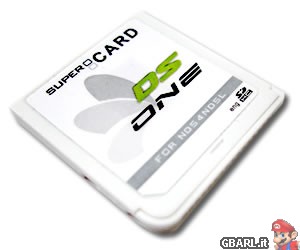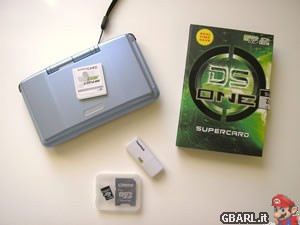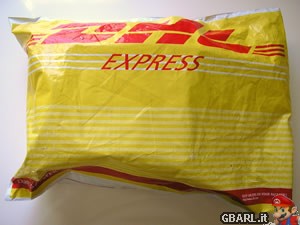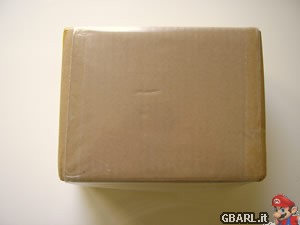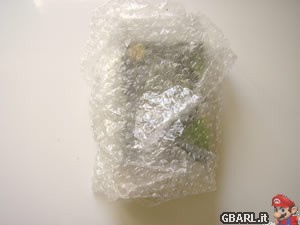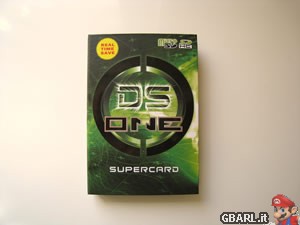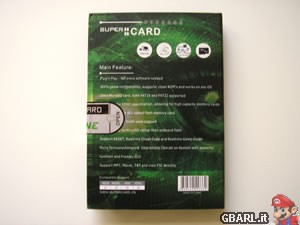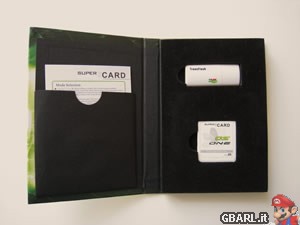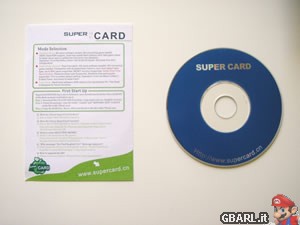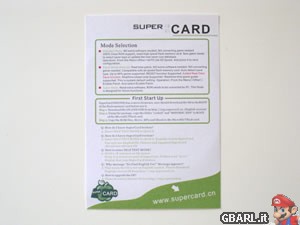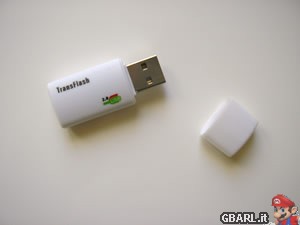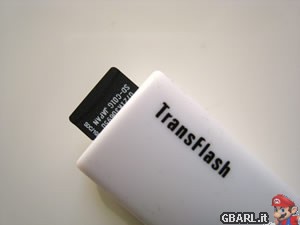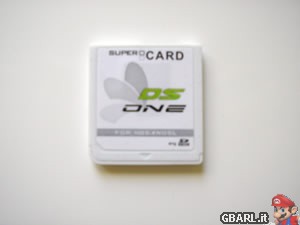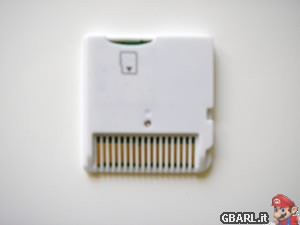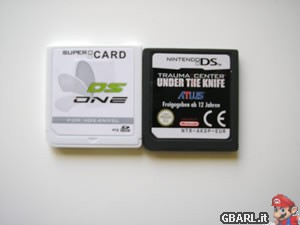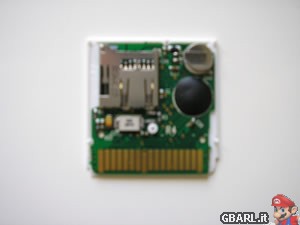Benvenuto Visitatore ( Log In | Registrati )
 Friday 22 February 2008 - 14:04 Friday 22 February 2008 - 14:04
Messaggio
#1
|
|
 The Evra Powwah! (Pirla) Gruppo: Veterani Messaggi: 10.824 Iscritto il: Fri 24 December 2004 - 19:38 Da: Nosgoth Utente Nr.: 3.467 Feedback: 0 (0%) |
Quick Links Homepage: http://eng.supercard.cn/ Updates: GbaRL.it Download Area Our thanks to Supercard Team and RomMan for the sample provided. Supercard: unless you're a complete newcomer in GBA/DS hacking, this name won't be unknown to you. This brand encompasses a wide range of successful and largely popular products going way back, to when touch screens were something you'd find on Star Trek and the GameBoy Advance was all the rage: that large, bulky blue cartridge with a taste for SD cards was, for many (and for myself), the first step into this side of the gaming world. Their winning streak isn't over, either: after a slow start, due to a system software with a fair amount of rough edges, the Supercard DS ONE Slot-1 kit affirmed itself as one of the most reliable, well-supported and feature packed flashcards on the market. The sale figures were more than enough for the team to just sit back and relax, yet over the last year there was a steady trickle of firmware updates, each of them improving performance or adding a new function; now, our site is proud to review the latest update of this already appreciated hardware, the Supercard DS ONE SDHC, which we'll commonly refer to as a 'Mk. II'. Introduction & Features Ease of use, excellent build, constant support: these three traits have always been Supercards' distinguishing features. That was true for the (relatively) old SD-and-CF-powered GBA flashes, and it still holds true for this new DS ONE: everything you need is in the cart, be it homebrew patching, advanced gaming options or music playback; a microSD is the only real requirement. Given how the team has always set the bar quite high, we expect nothing short of excellence from this hardware. As we briefly mentioned above, this is not a completely new design, but rather an upgraded version of the widely spread non-SDHC DS ONE, up to the point that system updates are shared between said models. As usual, let's open our review with a quick look at the feature list, as provided by the manufacturer:
Knowing the SC Team, though, we wouldn't define this list as "final": given certain design choices, we wouldn't be surprised if more features were added or expanded upon - real time save was announced completely out of the blue, after all - so is with these subtle promises in mind that we proceed with testing this unit. -------------------- Just keep tryin'
Keep on flyin' I will be the light... - from Last Exile: Cloud Age Symphony - Togisumasareta tsume wo hate ima kagayaku tame ni sono kiba wo muke... Shiren wa norikoerarenai hito ni osoikakari wa shinai! - from Megaman X8: Wild Fang - Proud supporter of EVAC Industry co.ltd. |
|
|
|
 |
Risposte
 Sunday 24 February 2008 - 19:50 Sunday 24 February 2008 - 19:50
Messaggio
#2
|
|
 The Evra Powwah! (Pirla) Gruppo: Veterani Messaggi: 10.824 Iscritto il: Fri 24 December 2004 - 19:38 Da: Nosgoth Utente Nr.: 3.467 Feedback: 0 (0%) |
It's with a slight sense of dčją-vu that we approach our workbench, if only for how many times we were faced with the yellow and red color scheme typical of DHL: the sample sent to us was the latest rolling out of the assembly line, although in late February 2008 the circuit board has been updated with minor changes, which we'll take into account later. This time, we received quite a sizeable package: once cutting open the outer envelope, we were presented with a sturdy cardboard box. The third image shows what's inside: our flashcard, nested within two rounds of bubblewrap. To say the DS ONE was well-protected would be a serious understatement: praises to the team for the care they took into packaging it, to the point we had to resort to something sharper that our standard pair of scissors to open up the box. Anyway, back to our Supercard DS ONE, with a look at the package, pictured below. Resembling a book, the DS ONE Mk. II box is identical to the one housing the previous, non-HC version of the card, although with a different color scheme and the latest features included. 'Matrix green' is the predominant tint, something we're accustomed with ever since that movie's release. On the front, not much has changed from the previous DS ONE: the card's logo takes nearly the entire space, along with the Supercard brand directly beneath and the 'i]microSD compatible[/i]' symbol in the top right corner; said markings are all embossed, which gives a pleasant additional touch to the overall finish of the box. Notable additions are the SDHC logo and a small, yellow mark which advertises one of the card's most notable features: real-time save. Once turned, we're presented with the usual full listing of the card's features, updated to include the latest additions from the SC Team, such as multi-saver and Supercard's own Blue Light Engine for optimal performance on a wide range of microSD I/O speeds; a barcode and the standard hardware compatibility breakdown are directly beneath. A touch of nostalgy: the four icons before the features list are the latest evolution of the "instruction manual" found on older Supercards, that being a set of pictures explaining in brief how to use the flashcard. The DS ONE package is factory-sealed by an adhesive strip, which doubles as both a warranty seal and a mean to keep the box closed: once carefully peeled off - it comes loose pretty easily, but we wouldn't advice you to simply rip it off to avoid causing damage - the contents are accessible. Luxurious: this is the first word that comes to our minds while detailing the innards of the package: on the left, a small pouch holds a one-sheet instructions manual and a somewhat more concealed miniCD with an older revision of the Supercard ONE OS (which will be further detailed in a while), while the entire right part is a large, black piece of foam which houses the DS ONE itself and a small microSD/HC reader. So far, this has been by all means one of the best card packagings we've seen: even without being made of tin, like those round G6 cans, the DS ONE box is well-built and finely printed (admittedly, we don't consider Engrish to be a problem), really shining once the user opens it. The card and card reader are well protected and everything is carefully arranged for ease of access, which is always a plus considering how such hardware is aimed not only at hackers and power users, but also at newcomers. Let's now take a closer look at the content, starting with the instructions manual and driver disc. Admittedly, more than a manual this small sheet of paper is more of a quick reference card, printed in both Chinese and English (one language per side), yet it proves useful for detailing basic operation of the hardware and an outline of its most advanced features, such as the three modes we'll describe in the relevant section of the review. We appreciated how crucial features such as the self-test mode were mentioned, along with common troubleshooting and firmware update questions; as complete as PDF manuals can be, printed instructions always prove invaluable for hardware as "uncommon" as flashcards. The only downside is the incredibly small font used: we were unsure whether to use a magnifier or not to read more clearly. Now, for the driver disc: interestingly enough, it contains not only the OS for the DS ONE, but also for all other Supercard products, proving useful for those users owning them and wishing to take full advantage of the already mentioned interaction between them and the DS ONE. Neverthless we'd advice downloading the latest version from the official site, seeing how the revision included is an old v3.0 released on December 2007. The Supercard DS ONE comes bundled with a compact microSD USB 2.0 reader, HC compatible. It features a simple yet elegant design, with a white plastic case and removable cap protecting the USB connector: the card slot is on top of the unit, where a small notch for attaching it to a keychain or necklare can also be found. When connected, it's automatically recognised by all major OS'es (we've tested Windows Vista and Ubuntu Linux) and a red LED lights up within the unit. Our complain for an otherwise excellent and stylish reader is how unprotected the microSD is: almost like the old Supercard CF, the card is only halfway inserted, hence prone to break should one accidentally hit it; on top of it, it broke down after roughly two weeks. Now, let's examine the flashcard itself: the DS ONE Mk.II is a Slot-1 flashcard, identical in size and shape to a standard, Nintendo produced cartridge, differing from its non-HC counterpart by its white shell and new sticker graphics, which covers the entire front. Once turned around, you will notice the drawing detailing the correct orientation for memory card insertion, as well as a tiny screw: the latter's role will be explained later. The microSD slot is spring-loaded: whether this is a pro or con it's somewhat of a matter of personal taste and build quality of the hardware; some manufacturers opted for springs, other did otherwise. As disastrous as it was the the older R4 revisions, we do prefer this kind of mechanism, as it allows for easier removal of the card, which would otherwise require one's fingernails. While the card will not stick from the top of the DS ONE (actually stopping half a millimeter short of it), the usual drawback of requiring a small fingertip or nails to apply pressure on it is unavoidable: the spring itself poses quite a bit of resistance against the microSD, something we assume is due to either the flashcard being brand new or the component's quality being remarkable. We mentioned a small screw on the back of the card: while other manufacturers chose either to keep the two halves of the shell joined by plastic clasps or by old plain glue (the latter something we are thoroughly annoyed with, to tell the truth), unscrewing it will grant easy access to the circuit board, as shown above. We didn't completely remove it from its casing as the components (namely the PSRAM module) on the back actually stick out from a hole in the shell and adhere to the sticker, but that's something that does not hinder the user when operating on the board. Owners of the older model will notice how the circuitry is now green, as opposed to red, although this is just a cosmetic change; we mentioned how, as of February 2008, the manufacturer seems to have updated the card's design: apparently, the only modifications were a relocation of the controller chip (hidden under a large drop of black epoxy in the pictures above) and the battery (whose function is unclear) moved in its place. This change is understandable if you think of one the DS ONE's greatest weaknesses: PSRAM. The entire Supercard series, ever since its first specimens, always used this component, whose failure almost invariably cripples the hardware. Lately, a noticeable batch of units turned out to be either faulty or extremely fragile in this regard, which explains the team's prompt redesign. Overall, this DS ONE Mk.II proves to be a well-built unit: the plastic shell is solid and safely kept closed by plastic pins and a single screw, something which ensures protection against accidents while allowing power users to take a peek inside; what did not convince us, though, was the choice (shared with other products such as the DS-Link, first-generation DSTT and EDGE DS) to keep the PSRAM vulnerable, covered only by the sticker. Seeing how another sensitive component -the internal battery- was moved to a safer place and how said memory chip is at the root of a common hardware fault trying to squeeze it inside the casing would've been wiser. -------------------- Just keep tryin'
Keep on flyin' I will be the light... - from Last Exile: Cloud Age Symphony - Togisumasareta tsume wo hate ima kagayaku tame ni sono kiba wo muke... Shiren wa norikoerarenai hito ni osoikakari wa shinai! - from Megaman X8: Wild Fang - Proud supporter of EVAC Industry co.ltd. |
|
|
|
Inserisci in questo messaggio
 Evrain [REVIEW] Supercard DS ONE Mk. II (SDHC) Friday 22 February 2008 - 14:04
Evrain [REVIEW] Supercard DS ONE Mk. II (SDHC) Friday 22 February 2008 - 14:04
 Evrain Getting Started
The DS ONE setup is extremely sim... Wednesday 27 February 2008 - 14:01
Evrain Getting Started
The DS ONE setup is extremely sim... Wednesday 27 February 2008 - 14:01
 Evrain GUI & System Software
Let's now switch on... Saturday 1 March 2008 - 13:07
Evrain GUI & System Software
Let's now switch on... Saturday 1 March 2008 - 13:07
 Evrain Compatibility and Performance
After taking care of... Monday 17 March 2008 - 13:28
Evrain Compatibility and Performance
After taking care of... Monday 17 March 2008 - 13:28
 Evrain Final Thoughts
And finally, our review reaches its... Monday 17 March 2008 - 20:10
Evrain Final Thoughts
And finally, our review reaches its... Monday 17 March 2008 - 20:10  |
1 utenti stanno leggendo questa discussione (1 visitatori e 0 utenti anonimi)
0 utenti:

|
Versione Lo-Fi | Oggi è il: Thu 19 June 2025- 09:31 |








